Saturday, December 25, 2004
Silvered Æ antoninianus, Gallienus, Siscia, Göbl 1472bvar
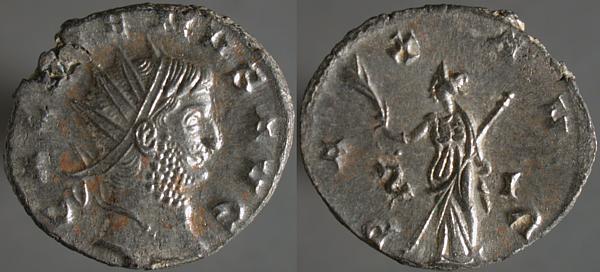
GALLIENVS AVG, Radiate head right | PAX AVG, Pax standing facing, head left, holding branch left and long scepter transverse. Retrograde S in left field, I in right.
Robert Göbl attests this coin only with the S in S_I not retrograde, but I've seen many like this in the market, and have two examples, from different dies. I think it's more a case of a mistake in the catalog than of a coin so uncommon that he hadn't seen one.
Friday, December 24, 2004
Æ tetradrachm, Alexandria, Valerian, Emmett 3703(5)

Α Κ Π ΛΙ ΟVΑ[ΛΕΡΙΑΝ]ΟC ΕVΕVC, Laureate cuirassed bust right | L_Ε, Alexandria standing facing, head left, holding scepter right and head of Serapis left. Regnal year across fields.
Some info on Serapis here. Alexandria, holding his head, is the personification of the city, founded by Alexander, capitol of Egypt under the Greeks and the Romans.
Thursday, December 23, 2004
Æ denarius, Gallienus, Rome, Göbl 661t
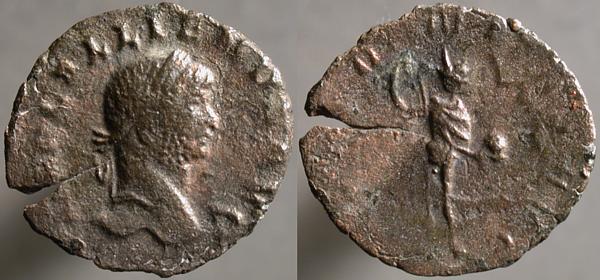
IMP GALLIENVS AVG, Laureate head right | AETERNITAS AVG, Radiate Sol standing facing, head left, holding globe right and raised hand left. [Γ in left field.]
Yay! Another denarius.
Wednesday, December 22, 2004
AR denarius, Geta, Rome, RIC 69b
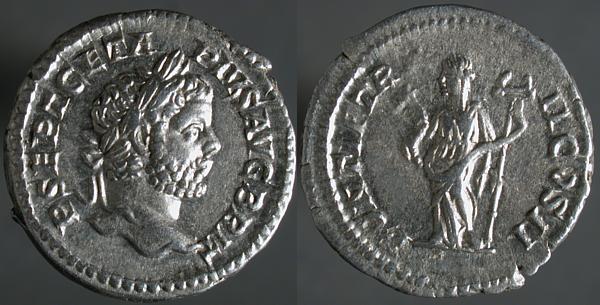
P SEPT GETA PIVS AVG BRIT, Laureate head right | PONTIF TR [P] II COS II, Felicitas standing facing, head left, holding long caduceus right and cornucopia left.
Publius Septimius Geta was the younger son of the emperor Septimius Severus, who raised him to emperor in 211 and died soon thereafter.
Geta and his older brother, Caracalla, soon fought for sole power, and Geta was murdered, in his mother's arms in some versions, by the end of the year.
Tuesday, December 21, 2004
Æ31, Flaviopolis in Cilicia, Valerian, Lindgren III, A835b
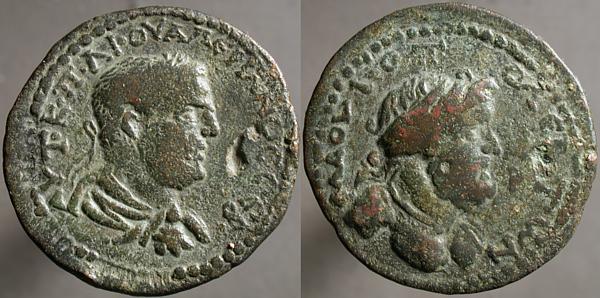
ΑVΤ·Κ·Π·ΛΙ·ΟVΑΛΕΡΙΑΝΟC·CΕΒ, Laureate draped cuirassed bust right | ΦΛΑΟVΙΟΠ_ΟΛΕΙΤωΝ, Laureate draped bust of Kronos right. [ΕΤ Α] /Π / Ρ in right field.
Flaviopolis, named for the family of Vespasian, is today the site of Kadirli, Turkey.
Kronos, father of Zeus, isn't commonly seen on coins (nor is his Roman counterpart Saturn), but does turn up at Flaviopolis, perhaps home to a temple of Kronos.
Monday, December 20, 2004
Silvered Æ antoninianus, Gallienus, Antioch, Göbl 1668q
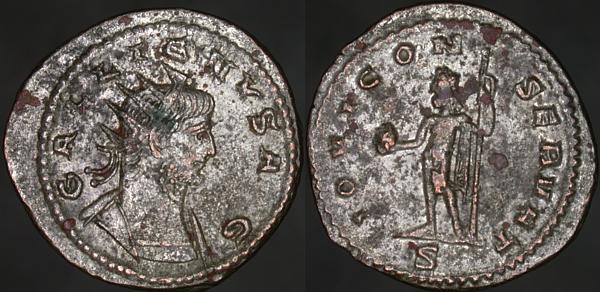
GALLIENVS AVG, Radiate cuirassed bust right | IOVI CONSERVAT, Jove standing facing, head left, holding long scepter right and globe left. S in exergue.
Robert Göbl attests a single example of this coin, but there is no photograph of it in the plates. (Similar coins with PXV in the exergue are far more common, and the difference, admittedly, is insignificant except to collectors of this series.)
Göbl's arrangement of the coins indicates that this is from one of the final issues of Antioch during Gallienus's life, which may explain its rarity: perhaps the issue ended long before it would have, had Gallienus continued to reign.
Sunday, December 19, 2004
Æ24, Smyrna in Ionia, quasi-autonomous, Klose p.196, n.3
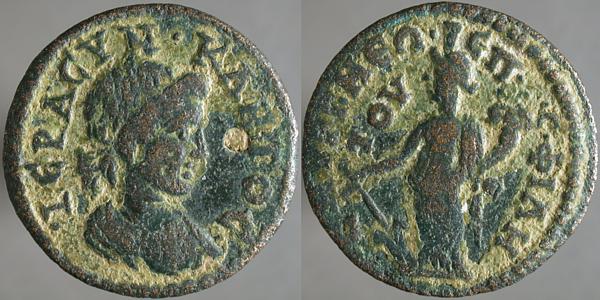
ΙΕΡΑCVΝ·ΚΛΗΤΟC, Laureate draped bust of the Senate right | [...]ΝΕΩ·C·ΕΠ·ΦΙΛΗ / ΤΟV, Tyche standing facing, head left, holding cornucopia right and rudder left.
A quasi-autonomous coin of the Valerian/Gallienus era, that features neither the name nor the image of any member of the imperial family, but instead, in this case, a civic personification.

